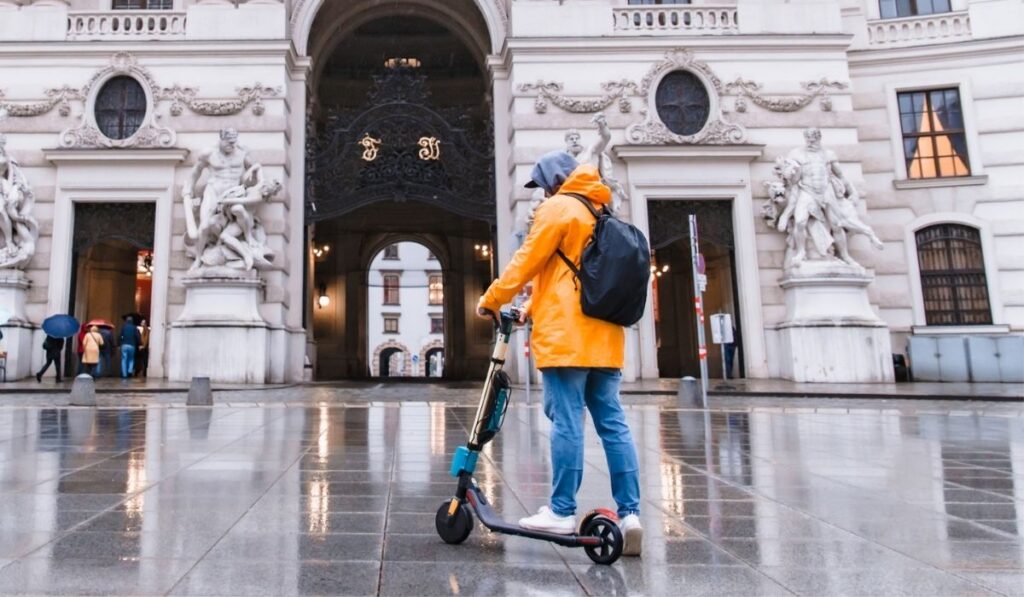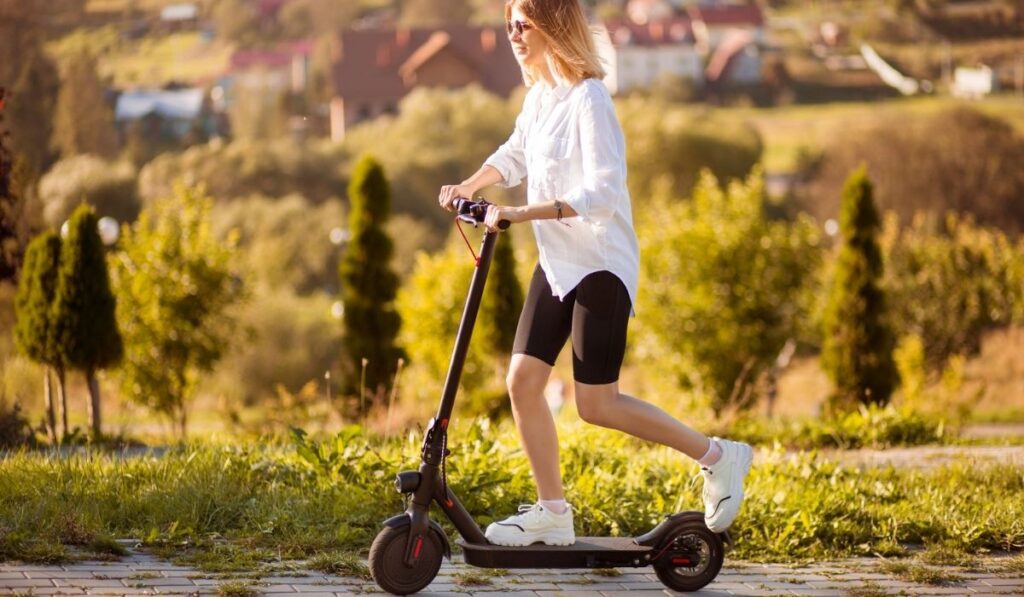Scooting instills a sense of balance, and it helps you develop muscle, coordination, decision-making skills, and cardiovascular endurance. But one main concern that scooter owners often have is how to protect their scooter from the rain.
You can protect your scooter from rain by covering the electrical components, patching up holes, lowering the tire pressure, and staying away from flooded or slippery areas. After the ride, use a wet-dry vacuum or a cloth to dry the scooter completely before storing it inside or under a waterproof cover.
Try not to ride in wet conditions if possible, but if you’ve got no choice, there are a number of ways to ensure that you and your scooter remain safe. Answers to all of the burning questions you may have about potential water damage are detailed in this article.
Why Should You Protect Your Scooter From Rain?

While most contemporary scooters have robust outer casings that protect them from the elements, this is not always the case. The sensitive electrical components of an e-scooter can be damaged if they are exposed to any type of moisture on a regular basis, and that includes rain.
Moisture can cause corrosion, which reduces your scooter’s lifespan. However, knowing how to properly maintain your e-scooter can help you significantly extend its life.
Some scooters have pretty high IP ratings, which means they can handle some rain, but it’s still a good idea to waterproof them even more if you can. There are several methods for waterproofing your electric scooter.
There are products such as a spray that can make something water repellant, which is especially useful. You can also make modifications to various parts and switch others for waterproof parts.
Before you do anything else, the connections must be shielded from harm. For this, you’ll need dielectric grease, which helps keep the connections dry and dust-free. It’s an antioxidant, too.
All components except for the LED indicators should then be professionally separated using liquid tape. You should use waterproofed battery bags and potting components wherever possible. For this job, we recommend the use of a hot glue gun.
If these extra measures don’t work out, we recommend starting your rainy adventure with an e-scooter that has been specifically designed to be water resistant. This will save you time and money, and disappointment, in the case that your DIY waterproofing is unable to withstand the rain.
How to Waterproof Your Scooter
To protect your electric scooter from the rain, you should make sure it’s been appropriately waterproofed. Depending on the type of scooter you have, there may be some tips that are particularly relevant, but there are also generic ideas that apply to virtually any scooter.
Here are 6 suggestions for making your e-scooter more water-resistant:
- You should seal up the cracks and holes in your deck, and keep duct tape handy in case you need it while you’re on the road.
- Screws and holes containing wires or cables should be o-ringed to prevent water from getting into them.
- Use silicone or superglue to patch up any holes.
- Clear adhesive tape or plastic covers can protect the screen, the controls, and other electrical components from damage.
- The mudguards should be expanded.
- Waterproof the connections and solders using a silicone-based conformal coating (electronics can be treated in the same way, although it’s more complicated).
- The axles of the motor wheels should be lubricated.
Ensure that your scooter is completely dry before folding it up after use. You can use a cloth or a wet-dry vacuum cleaner to dry your scooter if it’s damp. Never use a hairdryer!
Be sure to keep your scooter inside when it’s not in use. If you don’t have an indoor space available, get a water-proof cover.
The Dangers of Riding a Scooter in the Rain

There are additional considerations to keep in mind when riding in inclement weather. Manufacturers encourage riders not to use their electric scooters in the rain if they have alternative means of getting around.
This is because you risk harming the electrical system and the battery, especially when driving along flooded highways or through deep puddles. Never risk completely immersing your scooter’s electrical components and batteries in water.
Water-resistant is not synonymous with waterproof. If you need to ride your scooter in the rain, avoid flooded areas at all costs. If you become trapped in a flash flood, a deep puddle, or a rapid stream of water, your electric scooter will become useless, and you risk causing it irreversible harm.
While driving in the rain is not prohibited outright, it should be done sparingly. If there is only a bit of rain, put on a raincoat and you should be able to complete your journey safely. If it’s raining more heavily, pay careful attention to the amount of water on the road, and be aware of how far ahead you can see.
How to Prepare for the Rain Ahead of Time
Sometimes riding in the rain can’t be avoided. Be prepared by taking the following steps:
- Shop for an electric scooter of a high quality. An inexpensive electric scooter that is left outside in the rain for a long period can quickly rust.
- Fenders are a necessity if you plan on riding in the rain. If you don’t have fenders already, it’s time to invest.
- Riding in the rain necessitates the use of a raincoat or a similarly waterproof garment. In addition, you’ll want one that’s clearly visible, so that others on the road can see you. Avoid wearing dark colors like grey and black.
- Be sure you’ve waterproofed your bike and, if possible, use something like duct tape to cover the electrical components.
- Choose a slightly lower tire pressure when it’s raining. On slick terrain, lower tire pressure is beneficial, since it increases contact between the tire and the road and makes it less likely that you’ll skid. You’ll also have more traction and feel more secure on the turns if you do this. Tire pressure should always be increased when driving on the dry pavement after a storm.
- Use dielectric grease for the best results. Silicon-based grease repels water and protects electrical connections from corrosion and filth. Your electric scooter will not last long if this tip is ignored, even if it’s top-of-the-line. Be careful not to go overboard with the grease.
How to Be Safe While Riding in the Rain
Riding in the rain is a time to use extra caution by taking the following measures:
- Avoid large puddles.
- Take it easy. Not only should you ride more slowly, but you should also try to avoid making sudden turns. That way, you’ll be more prepared to respond should something go wrong.
- If possible, avoid freezing rain. Riding your electric scooter in warmer rain isn’t the end of the world, provided you’re properly equipped and suited. But when the weather is frigid and the rain is hurting your fingertips, it’s time to head home.
- Be mindful of crosswalks, metal manhole covers, railway tracks, and other slippery surfaces. In bad weather, these could prove lethal. Monitor the road and be cautious where you ride.
- Make sure you clean up afterwards. Regardless of the weather, you’ll be drenched. And if you don’t have fenders, you’ll also be covered in dirt from the road.
How Do You Find Your Electric Scooter’s IP Rating?
The IP rating is very important if you think your scooter may get wet at some point. The rating tells you how water resistant your scooter is, and it typically provides advisories related to riding in the rain.
Look in the owner’s manual for this information. If you don’t have the manual, you can typically google your model and find the specs you’re looking for.
IP ratings are denoted by the abbreviation “IP” followed by two digits. IP54 is the most frequent rating for electric scooters. The first number represents protection against solid objects, on a scale of 1 to 6. The second number reflects liquid resistance, in a range of 1 to 9. The higher the figure, the better.
Regardless of the IP classification, manufacturers will provide specific advice on the extent to which a scooter should be used in the rain. Two scooters with the same IP rating may therefore have different recommendations from the manufacturer regarding riding in wet situations.
This is for a variety of reasons. Firstly, it’s because the testing technique does not fully duplicate wet conditions seen in the real world. The manufacturer may be aware of a water vulnerability that was missed during the test.
Furthermore, manufacturers may wish to protect themselves from warranty claims resulting from water-damaged equipment. By advising you not to ride in certain conditions, they transfer the risks to the user.
What to Do When Your Electric Scooter Gets Wet
At some point, you’re probably going to run into bad weather, and your scooter will inevitably get wet. If your electric scooter gets very wet, turn it off right away, remove the battery, and put it somewhere covered until it dries.
Before storing your scooter, make sure you dry off any electrical components, clean your screen, and let the whole thing dry before folding it up.
When your electric scooter is not in use, cover it well. We recommend you always use a cover that is resistant to water, to protect your scooter from being damaged by excessive moisture or humidity.
Alternatively, you can use a canopy to shield your e-scooter from the elements.
